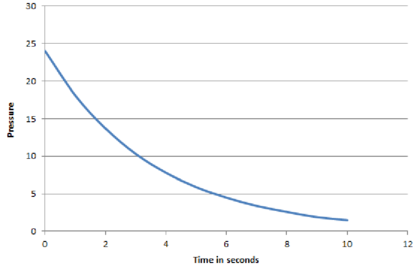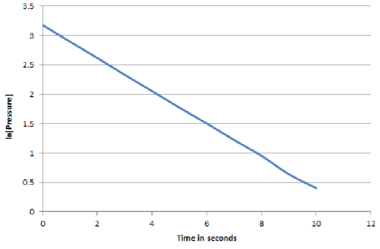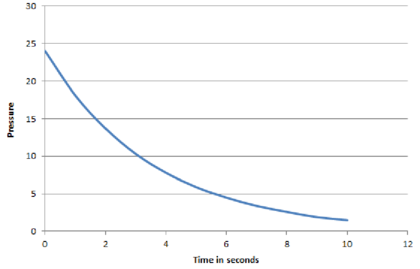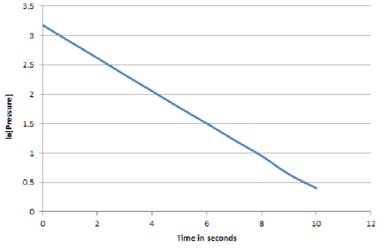
(a)
Interpretation:
The order of the decomposition of nitrogen dioxide has to be determined.
(a)
Explanation of Solution
The time and the pressure of the reactant is given as shown below;
| Time ( | Pressure of | Pressure of | |
Graph of concentration and time is plotted considering the time in x-axis and pressure of the reactant at

As the obtained graph is not a straight line, the reaction is not a zero order.
If the plot of graph with time and
| Time ( | Pressure of | |

As the obtained graph is a straight line, the reaction is a first order.
(b)
Interpretation:
Rate constant for the decomposition of nitrogen dioxide has to be determined.
(b)
Explanation of Solution
The time and the pressure of the reactant is given as shown below;
| Time ( | Pressure of | Pressure of | |
Graph of concentration and time is plotted considering the time in x-axis and pressure of the reactant at

As the obtained graph is not a straight line, the reaction is not a zero order.
If the plot of graph with time and
| Time ( | Pressure of | |

As the obtained graph is a straight line, the reaction is a first order. Therefore, the rate law can be given as shown below;
Rate constant for the reaction at
The rate constant of the first order reaction can be calculated as shown below;
The rate constant of the reaction at
Rate constant for the reaction at
The rate constant of the first order reaction can be calculated as shown below;
The rate constant of the reaction at
(c)
Interpretation:
Activation energy has to be calculated for the decomposition of nitrogen dioxide.
Concept Introduction:
Activation energy is the minimum amount of energy that has to be possessed by the reactant species in order to produce products. Activation energy is represented as
(c)
Answer to Problem 13.90QE
Activation energy of the reaction is
Explanation of Solution
The rate constants and temperature are as follows;
| Rate constant | Temperature |
Activation energy and the rate constants for a reaction at two different temperatures is related by the equation as follows;
Where,
Rearranging equation (1) in order to obtain activation energy, the equation is given as shown below;
Substituting the first and third entry from the table given above in equation (2), the activation energy can be calculated as follows;
Therefore, the activation energy of the reaction is
Want to see more full solutions like this?
Chapter 13 Solutions
Chemistry: Principles and Practice
- The decomposition of iodoethane in the gas phase proceeds according to the following equation: C2H5I(g)C2H4(g)+HI(g) At 660. K, k = 7.2 104 sl; at 720. K, k = 1.7 102 sl. What is the value of the rate constant for this first-order decomposition at 325C? If the initial pressure of iodoethane is 894 torr at 245C, what is the pressure of iodoethane after three half-lives?arrow_forwardAt 573 K, gaseous NO2(g) decomposes, forming NO(g) and O2(g). If a vessel containing NO2(g) has an initial concentration of 1.9 102 mol/L, how long will it take for 75% of the NO2(g) to decompose? The decomposition of NO2(g) is second-order in the reactant and the rate constant for this reaction, at 573 K, is 1.1 L/mol s.arrow_forwardFor a reaction involving the decomposition of Z at a certain temperature, the following data are obtained: (a) What is the order of the reaction? (b) Write the rate expression for the decomposition of Z. (c) Calculate k for the decomposition at that temperature.arrow_forward
- For a reaction involving the decomposition of a hypothetical substance Y, these data are obtained: Determine the order of the reaction. Write the rate law for the decomposition of Y. Calculate k for the experiment above.arrow_forwardOne possible mechanism for the decomposition of nitryl chloride, NO2CI, is What is the overall reaction? What rate law would be derived from this mechanism? What effect does increasing the concentration of the product NO2 have on the reaction rate?arrow_forwardThe Raschig reaction produces the industrially important reducing agent hydrazine, N2H4, from ammonia, NH3, and hypochlorite ion, OCl−, in basic aqueous solution. A proposed mechanism is Step 1: Step 2: Step 3: What is the overall stoichiometric equation? Which step is rate-limiting? What reaction intermediates are involved? What rate law is predicted by this mechanism?arrow_forward
- The catalyzed decomposition of hydrogen peroxide is first-order in [H2O2]. It was found that the concentration of H2O2 decreased from 0.24 M to 0.060 M over a period of 282 minutes. What is the half-life of H2O2? What is the rate constant for this reaction? What is the initial rate of decomposition at the beginning of this experiment (when [H2O2] = 0.24 M)?arrow_forwardThe initial rate ( [NO]/ t] of the reaction of nitrogen monoxide and oxygen NO(g) + 2O2(g) NO2(g) was measured for various initial concentrations of NO and O2 at 25 C. Determine the rate equation from these data. What is the value of the rate constant, k, and what are its units?arrow_forward
 Chemistry: Principles and PracticeChemistryISBN:9780534420123Author:Daniel L. Reger, Scott R. Goode, David W. Ball, Edward MercerPublisher:Cengage Learning
Chemistry: Principles and PracticeChemistryISBN:9780534420123Author:Daniel L. Reger, Scott R. Goode, David W. Ball, Edward MercerPublisher:Cengage Learning Chemistry & Chemical ReactivityChemistryISBN:9781337399074Author:John C. Kotz, Paul M. Treichel, John Townsend, David TreichelPublisher:Cengage Learning
Chemistry & Chemical ReactivityChemistryISBN:9781337399074Author:John C. Kotz, Paul M. Treichel, John Townsend, David TreichelPublisher:Cengage Learning Chemistry: Principles and ReactionsChemistryISBN:9781305079373Author:William L. Masterton, Cecile N. HurleyPublisher:Cengage Learning
Chemistry: Principles and ReactionsChemistryISBN:9781305079373Author:William L. Masterton, Cecile N. HurleyPublisher:Cengage Learning Chemistry: The Molecular ScienceChemistryISBN:9781285199047Author:John W. Moore, Conrad L. StanitskiPublisher:Cengage Learning
Chemistry: The Molecular ScienceChemistryISBN:9781285199047Author:John W. Moore, Conrad L. StanitskiPublisher:Cengage Learning Chemistry & Chemical ReactivityChemistryISBN:9781133949640Author:John C. Kotz, Paul M. Treichel, John Townsend, David TreichelPublisher:Cengage Learning
Chemistry & Chemical ReactivityChemistryISBN:9781133949640Author:John C. Kotz, Paul M. Treichel, John Townsend, David TreichelPublisher:Cengage Learning ChemistryChemistryISBN:9781305957404Author:Steven S. Zumdahl, Susan A. Zumdahl, Donald J. DeCostePublisher:Cengage Learning
ChemistryChemistryISBN:9781305957404Author:Steven S. Zumdahl, Susan A. Zumdahl, Donald J. DeCostePublisher:Cengage Learning





